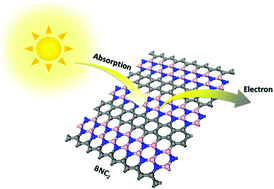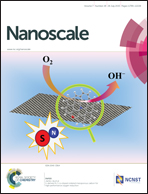Two-dimensional boron–nitrogen–carbon monolayers with tunable direct band gaps†
Abstract
The search for new candidate semiconductors with direct band gaps of ∼1.4 eV has attracted significant attention, especially among the two-dimensional (2D) materials, which have become potential candidates for next-generation optoelectronics. Herein, we systematically studied 2D Bx/2Nx/2C1−x (0 < x < 1) compounds in particular focus on the four stoichiometric Bx/2Nx/2C1−x (x = 2/3, 1/2, 2/5 and 1/3) using a recently developed global optimization method (CALYPSO) in conjunction with density functional theory. Furthermore, we examine more stoichiometries by the cluster expansion technique based on a hexagonal lattice. The results reveal that all monolayer Bx/2Nx/2C1−x stoichiometries adopt a planar honeycomb character and are dynamically stable. Remarkably, electronic structural calculations show that most of Bx/2Nx/2C1−x phases possess direct band gaps within the optical range, thereby they can potentially be used in high-efficiency conversion of solar energy to electric power, as well as in p–n junction photovoltaic modules. The present results also show that the band gaps of Bx/2Nx/2C1−x can be widely tuned within the optical range by changing the concentration of carbon, thus allowing the fast development of band gap engineered materials in optoelectronics. These new findings may enable new approaches to the design of microelectronic devices.


 Please wait while we load your content...
Please wait while we load your content...